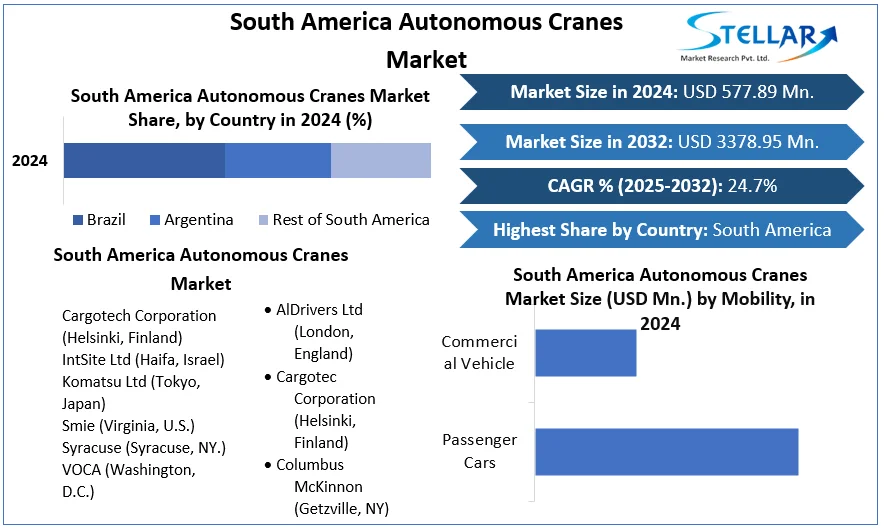South America Autonomous Cranes Market Industry Overview, Size, Share, Growth Trends, Research Insights and Forecast (2025–2032)
South America Autonomous Cranes Market was valued at USD 577.89 Million in 2024. Global South America Autonomous Cranes Market size is estimated to grow at a CAGR of 24.7% over the forecast period.
Format : PDF | Report ID : SMR_868
South America Autonomous Cranes Market Definition:
Autonomous cranes are mechanical equipment with wire ropes sheaves or chain hoists that use advanced technology software and hardware for material handling applications such as artificial intelligence (AI) and machine vision. Autonomous cranes are next-generation solutions for lifting and moving large items that provide many advantages like accident prevention, time-saving, and operation efficiency. Autonomous cranes are in their early stages of development and the majority of players are focused on Cranes Type development to meet the needs of customers. Autonomous cranes can be operated from the control room, allowing the operators to keep a close eye on the crane’s activity and maintain a high level of safety and comfort.
Further, the South America Autonomous Cranes Market is segmented by Mobility, Business Type, End-User Vertical, and geography. Based on mobility, the South America Autonomous Cranes Market is segmented under Static and Mobile. Based on the business type the market is segmented under the OEM and Aftermarket. Based on the end-user vertical the market is segmented into Building & Construction, Marine & Offshore, Mining & Excavation. By geography, the market covers the major countries in South America i.e.Brazil, Colombia, Venezuela, Chile, Rest of South America. For each segment, the market sizing and forecasts have been done based on value (in USD Million).

To get more Insights: Request Free Sample Report
South America Autonomous Cranes Market Dynamic
Despite several economic obstacles, the region’s economy is expected to develop during the forecast period because of positive government measures. Owing to the government policies supporting industrial growth the region has the highest urbanization rate in the world. With the growth of the industrial sector, the scope for integrating innovative machinery and equipment is also expected to increase. Food and drinks, oil, petroleum, natural gas, mining, and automobile are among the most developed industries in the region with a large number of production facilities. The use of autonomous cranes is anticipated to increase to help the manufacturing process in the industries. The high level of manufacturing automation in this region is expected to fuel the industry forward.
The use of cranes in the shipbuilding industry has increased significantly in recent years because of the increase in sea-borne trade and other naval activities. The automated gantry crane manufacturers on the market are concentrating their efforts on providing a diverse product line which is driving the market growth. The crane market is anticipated to grow during the forecast period because of the various advancement planned to improve the machine’s capabilities.
Autonomous Future: Driverless Cranes
The construction sector despite its adoption of innovation (R&D spending account for less than 1% of revenues) is in desperate need of change to address a rising shortage of competent personnel, a lack of standardization, and drop-in productivity and profitability. There are many reasons for the industry’s inefficiency like poor planning, mismanagement, human error, outdated equipment, and cranes are at the top of the list. It lifts 75% of material and equipment and is needed by a wide variety of users to perform a task in a project of all shapes and sizes. Cranes have an impact on the entire process but the estimated efficiency is only 55-65% with regular bottlenecks and costly delays.
The development of next-generation autonomous machines will require a variety of modern technology. The ability of a machine to replicate human intelligence is known as artificial intelligence (AI), the machine involves visual perception, translation, decision making, and speech recognition. Machine learning is a technique that allows the machine to learn from their mistake rather than designed precisely for each task. Computer vision (CV) refers to a machine’s ability to gather information about the surrounding through video cameras, process it, and then understand the images. BIM (Building information modeling) is a time-saving technology for planning and tracking construction projects.
All of these and many more are used by IntSite’s autonomous crane. The autonomous cranes will not eliminate the job of the crane operator, it will be in the loop to make sure everything is running smoothly and safely. Cranes operators will have the ability to override the machinery if needed. The ongoing design will heavily rely on their involvement, which will provide vital insights into the needs and issues that arise in the field, and prioritize the features that should be developed. IntSite is looking for a strong strategic partner in the world’s leading crane manufacturers. The ideal partner allows the company to move forward in many ways. They have the in-depth knowledge needed to validate the market, fund the IntSite team to grow and complete development, and IntSite’s solution that integrates future autonomous crane regulation with the crane core.
South America Autonomous Cranes Market Segment Analysis:
By End-User vertical Type, the AI-powered autonomous construction technology promises to grow rapidly during the forecast period by improving efficiency, reducing costs and building times, and reducing human errors and workplace-related injuries. The construction industry has occupied the largest market share. There has been strong growth in residential and non-residential construction.

South America Autonomous Cranes Market Key Players Insights:
The market is characterized by the existence of several well-known firms. These companies control a large portion of the market, have a wide product portfolio, and have a global presence. In addition, the market comprises small to mid-sized competitors that sell a limited variety of items, some of which are self-publishing organizations.
The market's major companies have a significant impact because most of them have extensive global networks through which they can reach their massive client bases. To drive revenue growth and strengthen their positions in the global market, key players in the market, particularly in South America, are focusing on strategic initiatives such as acquisitions, new collection launches, and partnerships.
The objective of the report is to present a comprehensive analysis of the South America Autonomous Cranes market to the stakeholders in the industry. The report provides trends that are most dominant in the South America Autonomous Cranes market and how these trends will influence new business investments and market development throughout the forecast period. The report also aids in the comprehension of the South America Autonomous Cranes Market dynamics and competitive structure of the market by analyzing market leaders, market followers, and regional players.
The qualitative and quantitative data provided in the South America Autonomous Cranes market report is to help understand which market segments, and regions are expected to grow at higher rates, factors affecting the market, and key opportunity areas, which will drive the industry and market growth through the forecast period. The report also includes the competitive landscape of key players in the industry along with their recent developments in the South America Autonomous Cranes market. The report studies factors such as company size, market share, market growth, revenue, production volume, and profits of the key players in the South America Autonomous Cranes market.
The report provides Porter's Five Force Model, which helps in designing the business strategies in the market. The report helps in identifying how many rivals exist, who they are, and how their product quality is in the South America Autonomous Cranes market. The report also analyses if the South America Autonomous Cranes market is easy for a new player to gain a foothold in the market, do they enter or exit the market regularly, and if the market is dominated by a few players, etc.
The report also includes a PESTEL Analysis, which aids in the development of company strategies. Political variables help in figuring out how much a government can influence the South America Autonomous Cranes market. Economic variables aid in the analysis of economic performance drivers that have an impact on the South America Autonomous Cranes market. Understanding the impact of the surrounding environment and the influence of environmental concerns on the South America Autonomous Cranes market is aided by legal factors.
South America Autonomous Cranes Market Scope:
|
South America Autonomous Cranes Market |
|
|
Market Size in 2024 |
USD 577.89 Mn. |
|
Market Size in 2032 |
USD 3378.95 Mn. |
|
CAGR (2025-2032) |
24.7% |
|
Historic Data |
2019-2024 |
|
Base Year |
2024 |
|
Forecast Period |
2025-2032 |
|
Segment Scope |
By Business Type
|
|
By Mobility
|
|
|
By End-User Vertical
|
|
|
Country Scope |
Brazil Argentina Rest of South America |
South America Autonomous Cranes Market Key Players:
- Cargotech Corporation (Helsinki, Finland)
- IntSite Ltd (Haifa, Israel)
- Komatsu Ltd (Tokyo, Japan)
- Smie (Virginia, U.S.)
- Syracuse (Syracuse, NY.)
- VOCA (Washington, D.C.)
- AlDrivers Ltd (London, England)
- Cargotec Corporation (Helsinki, Finland)
- Columbus McKinnon (Getzville, NY)
- Schneider Electric (Rueil-Malmaison, France)
Frequently Asked Questions
The Construction & building region is expected to hold the highest share in the South America Autonomous Cranes Market.
. The market size of the South America Autonomous Cranes Market by 2032 is expected to reach USD 3378.95 Million.
The forecast period for the South America Autonomous Cranes Market is 2025-2032.
The market size of the South America Autonomous Cranes Market in 2024 was valued at USD 577.89 Million.
- Scope of the Report
- Research Methodology
- Research Process
- South America Autonomous Cranes Market: Target Audience
- South America Autonomous Cranes Market: Primary Research (As per Client Requirement)
- South America Autonomous Cranes Market: Secondary Research
- Executive Summary
- Competitive Landscape
- Stellar Competition matrix
- South America Stellar Competition Matrix
- Key Players Benchmarking: - by Product, Pricing, Investments, Expansion Plans, Physical Presence, and Presence in the Market.
- Mergers and Acquisitions in Industry: - M&A by Region, Value, and Strategic Intent
- Market Dynamics
- Market Drivers
- Market Restraints
- Market Opportunities
- Market Challenges
- PESTLE Analysis
- PORTERS Five Force Analysis
- Value Chain Analysis
- Stellar Competition matrix
- South America Autonomous Cranes Market Segmentation
- South America Autonomous Cranes Market, by Business type (2024-2032)
- OEM
- Aftermarket
- South America Autonomous Cranes Market, By Mobility (2024-2032)
- Static
- Mobile
- South America Autonomous Cranes Market, By End User Vertical (2024-2032)
- Building & Construction
- Marine & Offshore
- Mining & Excavation
- South America Autonomous Cranes Market, by Country (2024-2032)
- Brazil
- Colombia
- Venezuela
- Chile
- Rest of South America
- South America Autonomous Cranes Market, by Business type (2024-2032)
- Company Profiles
- Key Players
- Cargotech Corporation
- Company Overview
- Product Portfolio
- Financial Overview
- Business Strategy
- Key Developments
- IntSite Ltd
- Komatsu Ltd
- Smie
- Syracuse
- VOCA
- AlDrivers Ltd
- Cargotec Corporation
- Columbus McKinnon
- Schneider Electric
- Cargotech Corporation
- Key Players
- Key Findings
- Recommendations
















